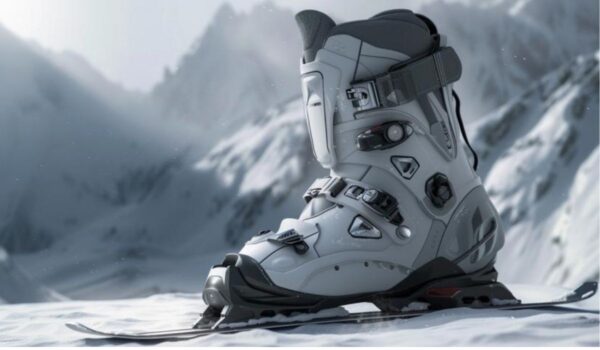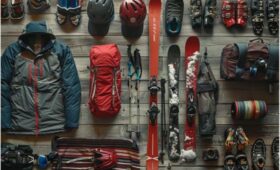
Ski boots are a crucial component of your skiing equipment, directly affecting your control and performance on the slopes. Finding the right fit is essential for both comfort and precision, allowing you to fully enjoy your time on the mountain. This guide will walk you through the key factors to consider when choosing ski boots, from skier type to size, fit, last/width, volume/instep height, flex/stiffness, and features.
Key Takeaways:
- Choosing the right ski boots is crucial for comfort, control, and performance on the slopes.
- Factors to consider include skier type, size, fit, last/width, volume/instep height, flex/stiffness, and features.
- Beginner/intermediate skiers should opt for softer to medium flexing boots, while advanced/expert skiers should choose stiff or very stiff flex.
- Ski boots are measured in Mondopoint sizing, and it’s advisable to seek the assistance of a professional boot fitter for a precise fit.
- Consider the shell fit and last/width to ensure optimal performance and comfort.
How to Choose the Right Size Ski Boots
Ski boots are an essential piece of equipment for any skier, and finding the right size is crucial for comfort and performance on the slopes. Ski boots are measured using the Mondopoint system, which is based on the length of your foot in centimeters. To ensure an accurate measurement, it is recommended to have your feet measured by a professional boot fitter.
While the indicated size on the ski boot can provide a good starting point, there are several factors to consider when choosing the right size. First, assess your ski ability, desired fit, and performance requirements.
For beginner and intermediate skiers: It is generally recommended to choose a boot close to your indicated size or slightly larger. This allows for a more forgiving and comfortable fit, which is ideal for those who are still developing their skills on the slopes.
For intermediate and advanced skiers: Opt for a boot close to your indicated size or slightly smaller. This provides a more precise and responsive fit, allowing for greater control and performance on more challenging terrain.
For advanced and expert skiers: Many skiers at this level prefer a shell size that is 1/2 to a full size smaller than their indicated size. This tighter fit ensures maximum control and power transfer, enhancing overall performance.
It’s important to note that ski boot manufacturers do not produce half sizes for shells. Therefore, if you choose to size down, you will need to go a whole size smaller. For example, if your indicated size is 27.5, and you decide to size down, you will need a 27 shell.
Additionally, it’s worth considering that ski boots will typically fit looser after a few days of skiing. Therefore, it’s advisable to aim for a perfect fit at the end of the season rather than when the boots are brand new.
By carefully considering your ski ability, desired fit, and performance requirements, as well as seeking the expertise of a professional boot fitter, you can ensure that you choose the right size ski boots for a comfortable and enjoyable skiing experience.
How Should Ski Boots Fit?
Ski boots should have a snug fit without cutting off circulation or causing painful pressure points. Proper ski boot fit is crucial for both comfort and performance on the slopes. When trying on ski boots, there are a few key factors to consider to ensure a proper fit and optimal ski boot comfort.
1. Pressure on the Toes
When the ski boots are buckled and your leg is upright, there should be slight to moderate pressure on the longest toes. This is usually an indication that the boots are the right size. However, it’s important to avoid excessive pressure or discomfort as this can affect circulation and cause pain during skiing.
2. Heel Placement
Flexing the ski boot hard with the upper buckles buckled can help push the heel back into the heel pocket and create more space in the front of the boot. This ensures proper heel placement and prevents the toes from hitting the front of the boot while skiing. It’s important to find a balance between a snug fit and enough room for your toes to wiggle comfortably.
3. Liner Check
Checking the fit of the liner without the boot shell can help pinpoint the source of any pressure or discomfort. Ensure that the liner is properly aligned and securely in place, without any noticeable gaps or folds. The liner should fit snugly around your foot, providing support and cushioning.
4. Break-in Period
Keep in mind that ski boots will often become more relaxed and mold to your feet after a few days of skiing. While it’s important to have a comfortable fit from the start, also consider how the boots may stretch and adjust over time. A slightly tighter fit initially may result in a perfectly snug fit after a few days on the slopes.
5. Sock Choice
Choosing the right pair of socks is crucial for ski boot comfort and control. Thin or very thin socks are recommended to minimize excess bulk and allow for better sensitivity to the ski boot. Avoid wearing thick socks or multiple layers, as this can create discomfort and affect the overall fit of the boot.
By following these guidelines for proper ski boot fit, you can ensure a comfortable and enjoyable skiing experience. Remember to consult with a professional boot fitter for personalized advice and assistance in finding the perfect ski boot fit for your feet.
Ski Boot Shell Fit and Last/Width
When it comes to choosing ski boots, the shell fit and last/width are crucial factors to consider for optimal comfort and performance on the slopes. Let’s dive deeper into these important aspects.
Ski Boot Shell Fit
The shell fit refers to how the ski boot fits your foot inside the outer shell. A good performance fit is typically described as a “one finger” or “one-and-a-half finger” fit, meaning there should be approximately 15-22 mm (0.6 to 0.9 inches) of space between your heel and the back of the shell. This ensures a snug yet comfortable fit that allows for precise control and power transfer.
It’s important to note that having more than two fingers of space in the shell indicates that the boot is too big, compromising your control and responsiveness. On the other hand, having less than one finger of space falls into the “race fit” range, where the boot is extremely tight for enhanced performance but may sacrifice comfort.
Ski Boot Last/Width
The last or width of a ski boot refers to the shape and width of the forefoot area. Ski boot manufacturers offer different lasts to accommodate various foot shapes and widths. Narrow lasted boots are designed for skiers with narrow and low-volume feet, providing a snug and precise fit. On the other hand, average lasted boots are suitable for medium-width feet.
Boot fitters can make adjustments to the shell to ensure a proper last/width that suits your individual foot shape. Their expertise will help you find the right balance between comfort and performance, allowing you to ski with confidence.
Remember, finding the perfect shell fit and last/width is essential for optimal comfort and control on the slopes. Consulting with a professional boot fitter is highly recommended to ensure you choose the right ski boots for your specific needs.
Conclusion
Choosing the right ski boots is crucial for an enjoyable and successful skiing experience. By considering factors such as skier type, size, fit, last/width, volume/instep height, flex/stiffness, and features, skiers can find the perfect boots to enhance their performance on the slopes.
Getting a proper fit is essential, and it is highly recommended to seek the assistance of a professional boot fitter. These experts can provide personalized advice and ensure that the boots fit snugly without causing discomfort. This personalized approach is especially important because ski boot sizing is based on Mondopoint measurements, which may differ from traditional shoe sizes.
When it comes to shell fit and last/width, finding the right balance is key. A snug fit with a “one finger” or “one-and-a-half finger” space (15-22 mm or 0.6 to 0.9 inches) is considered optimal for performance. Additionally, choosing the appropriate last/width will ensure that the boots match the individual’s foot shape and provide the necessary support and comfort.
By following this ski boot buying guide and selecting the right ski boots through careful consideration, skiers can maximize their control, comfort, and overall skiing performance. Whether hitting the slopes as a beginner, intermediate, or advanced skier, choosing the right ski boots is a crucial step for an amazing skiing adventure.


